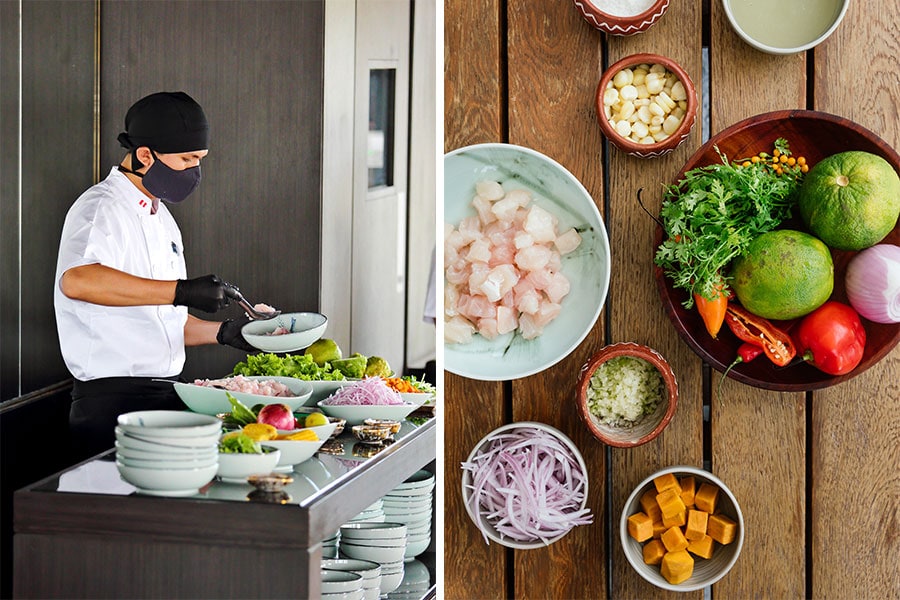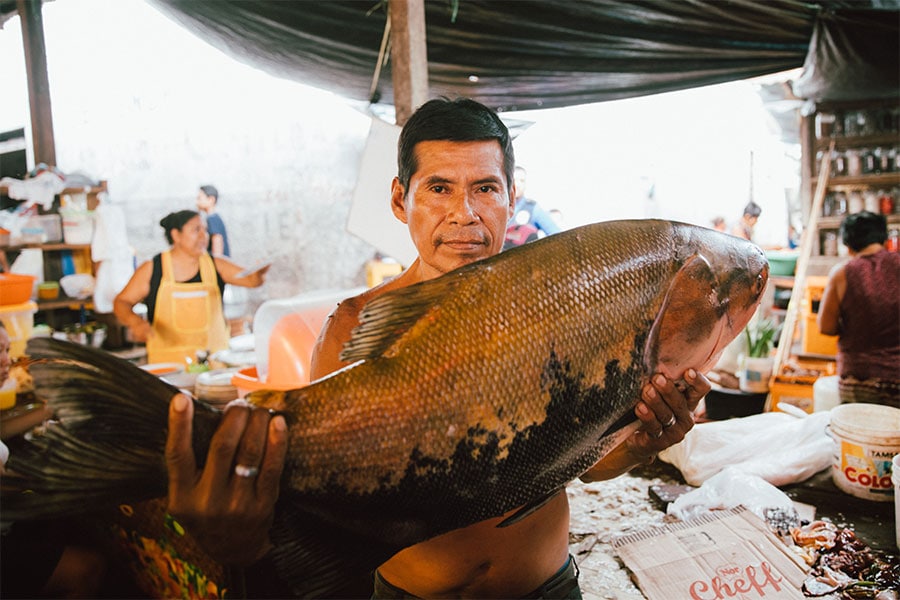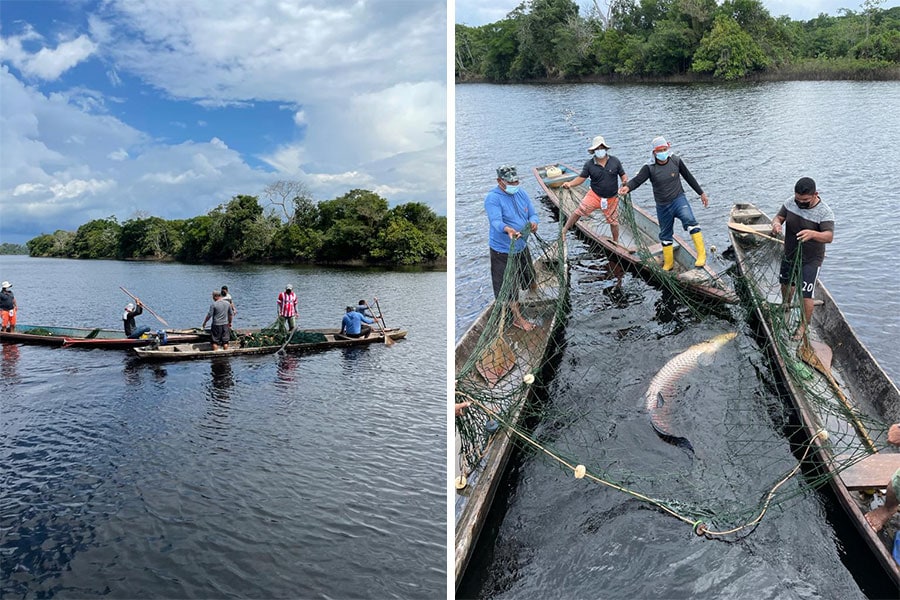
Food as a Vehicle for Change: Q&A with Pedro Miguel Schiaffino
Since the founding of Aqua Expeditions, award-winning Peruvian chef Pedro Miguel Schiaffino has been leading the world-class dining experience offered onboard our Amazon vessels. He combined his passion and knowledge of the Amazonian region and Peruvian cuisine with a profound curiosity to explore the exotic and largely undiscovered ingredients found in the vast rainforest and their uses in the traditional culture of local communities. This transcends his métier as a chef to become one of the greatest advocates for conservation in the region. Through gastronomy, he puts Amazonian cuisine on a global stage, raising awareness of the remarkable produce this region has to offer. He works closely with local producers to build a sustainable supply chain that results in high-quality products, helping to improve their livelihood and preserve their ancient traditions.
Get inspired by Chef’s Schiaffino’s innovative approach to cuisine and his unique views on how it can act as a catalyst for change and conservation.

Credits: Shirley Meléndez and SERNANP
1. Tell us about your first impressions of the brand-new Aqua Nera vessel?
Aqua Expeditions has really elevated the standard of luxury in the Amazon and South America, through the details, the architecture, the décor, and the materials used. Everything has been upgraded and carefully thought out to provide a personalized experience. The Aqua experience is all about top-quality service for the guest; including the bar and kitchen, which have been designed for a better flow, enhancing the guest experience.
2. What is behind the “rainforest-to-table” concept of Aqua Nera’s menu?
The “rainforest-to-table” movement aims to showcase the Amazon and its cuisine to Latin America and the world. Now more than ever is the moment for food to bring people closer to the Amazon. Gastronomically, the Amazon’s unexplored pantry, the high quality of its produce, its traditional cooking techniques, and the importance of its native communities’ culture, are incredible frontiers. This movement also helps to protect the rainforest by creating sustainable local business highlighting values of its culture and food.
3. What can guests expect from the dining experience at Aqua Nera?
In a place where the core of the experience occurs outside the restaurant, with the amazing rainforest, the river, and the wildlife, our goal is to complement this experience through cuisine that is fresh and healthy with the use of as many local ingredients as possible, highlighting the local flavor.

From the very beginning, Francesco (Aqua Expeditions CEO & Founder) expressed his wish that guests shall get a full taste of what Peruvian cuisine is about by offering an immersive culinary journey. We don’t focus solely on classic Amazonian food but also mix cuisines from different regions of Peru such as the coast, and some Andean-inspired dishes that can include trout, quinoa, huacatay, and other Andean herbs. But we also have an Italian lunch day recognizing Francesco’s heritage, as well as serve some Nikkei cuisine and Asian-influenced dishes incorporating ingredients and recipes from our Aqua chefs in the Mekong and Indonesia. As we work on a seven-night menu, we try to balance the overall dining experience to offer something different every day. The creative Peruvian cocktails at the bar also add an important element to the F&B experience.

4. We know over 70 percent of all produce used onboard is sourced locally, how is the process of finding ingredients in the vast Amazon region?
We’ve learned a lot over the past ten years via Aqua Expeditions, my restaurants in Lima, and the work we’ve done with the indigenous communities and local purveyors of the Amazon. It’s been challenging (and still is) to source good quality products from the Amazon region because there are no supply chains as we know it, and no established markets to drive this development. People collect the produce in a very natural way, without focusing on building a sustainable supply chain. You have to learn how to navigate through these limitations, find the right producers to work with, and take it to a professional level. Making this possible takes time and effort.

One great example of a project that has been getting better and better at managing a sustainable supply chain is the paiche project. For years, the paiche (Arapaima gigas), the largest fish in the Amazon, has been exploited, bringing the species to a vulnerable state. We have been working for more than 10 years with a community of artisanal fisherman to recover the paiche population, in an effort that has included training the fisherman inadequate management and supporting the logistics chain and development of a market through gastronomy and products with added value.
The current numbers for the paiche population are good and safe again. This group of fishermen are helping not only to make the resource sustainable, but getting more income from it, with the same amount of catch per year. This way, we can reduce the quantity of fish that is taken from the river, which is what we are looking for. Fisheries around the world are collapsing and the pressure on fish supply is growing each year so you have less fish in the ocean and the recuperation time is slower. Even though there are regulations in place, we need to make more efforts to preserve the fish in the ocean. The river is a good way to take pressure out of the ocean but in a sustainable way, so it doesn’t suffer in the same way.

The Promape (program of fishing management) in Peru for the paiche is the first and only program to be successful in the Amazon. They have been doing this for 12 years and they have collected a lot of data. It serves as an example for other groups of fishermen to become more organized as they are starting to understand the benefits of a higher quality product like this.
Again, it is important to stress that there was no market to drive the development of this product, so this is one of the things we have been working on with different partners such as Aqua Expeditions, restaurants, and chefs in Lima, as well as try to create a market locally in Iquitos since a lot of the local markets are informal. We are collaborating with the regional government to help implement the guidelines for this to be possible.
5. Please tell us more about other community-based projects in the Amazon you are working on that focus on sustainability and gastronomy.
The Black Tucupí or Tucupí Negro is a project that has an even greater social impact in the community. This is a sauce extracted from wild manioc (yucca brava) through ancestral methods that have been part of the communities’ heritage for generations. It is produced by a group of women from the communities along the river Ampiyacu basin, where traditionally women stay home and take care of the children. This project helps empower these women making it possible for them to contribute to their family’s economy, but it takes time and effort as you have to be careful how to approach the community in order not to create a disruption and differences within the community.
The main goal is for people in these communities to feel proud of their culture. We can see that they are now recovering old recipes, ingredients, and traditions, going back in time to ancient cooking techniques. Through these types of projects, we are also helping the community to have a better diet because it activates the local farms that were forgotten due to the introduction of occidental eating habits, wheat products, milk, sugar…ingredients that are not found locally in a natural way. We should be focused on learning and understanding how they used to eat in order to help preserve their traditions and culture, incorporating these products into the lifestyle of the new generations.
It is a challenge, but we are trying to make this happen through gastronomy, the menus of Aqua, and our restaurants. These are the best showrooms to put these amazing products on display and the vehicles to communicate with a broader audience to raise awareness.
6. Can you describe some exotic ingredients used in the menu that are native to the Amazon region and our readers may not know about?
The cocona sauce and the charapita pepper are condiments that we serve on the table every day at Aqua Nera as they add a very special flavor to any dish and are very popular in Amazonian cuisine. We’re the only ones that use cocona as much as we do, and you cannot find it almost anywhere else. Sacha culantro, sweet chili peppers, charapita pepper, achiote, turmeric, Amazonian lime…they are all basic daily ingredients that create the flavor profile of the Amazon. I love to use these basic ingredients; they are such amazing products, and it’s hard to understand why we still can’t find them easily in the city.

The Tucupí is a new product for us at Aqua, one of the most interesting ingredients we serve here but also completely unknown in the city. We use it as a table sauce for bread for example, and a bit for the patarashca (a fish dish wrapped in plaintain leaves). Another example is the cassava that we serve during breakfast, which comes from the same community of 30 women that produce the Tucupí. The tapioca is amazing because it’s super healthy, it’s a natural probiotic, and it’s a food that has existed for thousands of years and a staple ingredient in Amazonian cuisine. At Aqua we pay attention to the fact that these products are not only healthy but tasty and interesting.
The aguaje is another great example, it is so demanded and consumed in the Amazon, and guests are always surprised by the incredible aguaje pie we prepare onboard for dessert.
Looking forward, we are currently working on a project to create an Amazonian caviar from wild carachama fish. This year we will be performing a couple of tests, learning from the harvest of the sturgeon caviar in Spain, the US and Uruguay, so we can learn the process and try to replicate it here in Iquitos in a sustainable way. Of course, Aqua Expeditions is going to be heavily involved in this new project and we will also try to involve other players who are important for us such as chefs, the government, and the CITE Pesquero (Center of Innovation and Technology for Fishing).
7. Lastly, what is your favorite activity/excursion while on an Aqua Expeditions Amazon voyage?
Going to Yarina lake, where the paiche project is based. The route from the ship to the lake is amazing, I love it as we go deeper into the rainforest and when the river is low, we can see even more wildlife. This is a full day excursion which is included on the four-night itinerary.

Embark on a journey of discovery aboard the brand-new Aqua Nera, where everyday is a new opportunity to connect with Peruvian culture and tradition through Chef Schiaffino’s authentic culinary creations. Indulge in the luxurious amenities Aqua Nera has to offer and join our expert naturalists on twice daily excursions filled with adventure and countless encounters with the exotic wildlife of the Amazon rainforest. Contact us to learn more.


